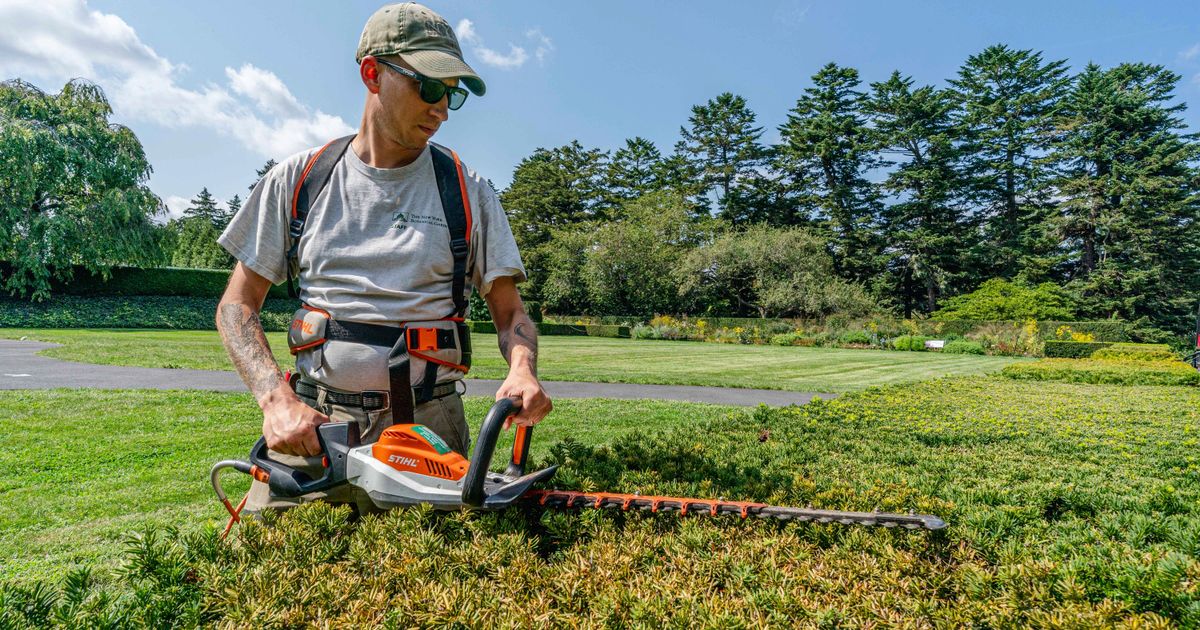[ad_1]
For Jared Anderman of Croton-on-Hudson, New York, switching from gasoline-powered tools to power tools for lawn care was a no-brainer.
“I am concerned about climate change and wanted tools that are more environmentally friendly, and also quieter. I like to listen to music when I am gardening and that way I can enjoy music or a podcast while I am working, â€he said. “I could never do that with gasoline equipment. “
The biggest benefit of all, he says, is maintenance. “Gasoline mowers are a pain. With power tools, they start right away and there is really no maintenance at all. It’s just a matter of keeping the batteries charged.
First, he bought an electric lawn mower. Then an electric hedge trimmer, a hedge trimmer and a leaf blower. “I don’t have an electric snowblower yet. But when I replace the gasoline snowblower, it will be an electric one, â€he says.
There is a quiet transformation underway in yards across the country. Long-standing complaints about the roar and fumes of leaf blowers, mowers and other gas-powered equipment have grown even louder as more people work from home due to the pandemic.
Meanwhile, the quality of zero to low emission electric landscaping equipment has improved markedly, with battery packs that last longer.
“Batteries have changed a lot in the last year alone, and we’re there in terms of the technology. Now it’s just about getting the word out to professionals and consumers, â€says Kurt Morrell, associate vice president for horticultural operations at the New York Botanical Garden.
“Last year we were 90 percent electric on the hedge trimmers and this year it’s 100 percent. My guys won’t even touch a gasoline hedge trimmer anymore, â€says Morrell, who oversees the trimming of the garden’s 4,850 linear feet of hedges.
There are even standalone lawn mowers like the Roomba vacuum cleaner.
“They’re really taking off, and in the next four or five years you’ll see more and more robotic mowers in the private sector,†says Morrell.
Morrell, who also teaches aspiring landscaping professionals, says that while electric edgers and mowers are now as good as or better than the gas-guzzling versions, cordless electric leaf blowers are still a challenge “because they require a lot of speed and power, and the weight of the battery at this point is much heavier than gas.
But technology is changing rapidly, he says. “When I teach my landscaping management students, who are going to manage large landscapes, I know they will be using electrical equipment. “
Power tools and some cleaner gas options only re-think many lawn care practices and their effects on the environment.
Many gardeners and landscapers are moving away from “a hyper-managed leaf drying standard”, for example, in favor of “just letting the leaves be leaves, some of them remaining on the ground”, explains Daniel Mabe , founder of the association. American Green Zone Alliance (AGZA), which provides homes, businesses, and organizations across the country with certification for low-carbon landscaping.
According to experts, leaving more leaves, plant stems and other garden debris to cover garden beds during the winter helps soil, insects and other wildlife.
When power tools are needed, the switch from gas to electric is reminiscent of the trend towards electric cars.
According to the California Air Resources Board, a department of the California Environmental Protection Agency, running a gasoline leaf blower for an hour can create as much smog-forming pollution as driving a 1,100-mile Toyota Camry. .
The battery-powered lawn equipment industry is growing at a rate three times faster than gas, according to the Freedonia Group, a division of MarketResearch.com.
“In terms of residential adoption of electric landscaping equipment, at least here in California, it’s already around 50%,†says Mabe.
He finds greater resistance to electrical equipment among professional landscaping companies than among residential consumers. But he estimates that there are at least 200 “all-electric†landscaping companies today. Many of them use robotic technology, program and maintain the lawn equivalent of Roomba.
Andrew Bray, vice president of government relations for the National Association of Professional Landscapers in Fairfax, Va., Said, “The transition to electricity is inevitable and most landscapers try out this equipment all the time. But while the technology is already here for homeowners – and I use electrical equipment in the home myself – the technology is not yet there for most of the commercial sector.
“With leaf blowers, for example, they don’t yet have the battery power needed for commercial use,†he says.
And he said there are cost and infrastructure hurdles for professional landscapers looking to switch from gas to electricity.
“Since battery packs are not interchangeable between tool brands, you will need to modernize your entire workshop so that everything is the same brand. You will also likely need to upgrade the power of your workshop’s electrical system, as an average crew would need around 36 batteries, â€he says.
Yet the electric momentum is growing. Stanley Black & Decker, a leading manufacturer of outdoor products, estimates that the volume of electric landscaping equipment shipped by North American manufacturers has grown from 9 million units in 2015 to over 16 million units. million last year, an increase of over 75% over the past five years. years.
“We continue to innovate in wireless (electrical) products focused on providing high performance while having less noise and zero emissions in use,†said John Wyatt, senior vice president of Stanley Outdoor.
[ad_2]

